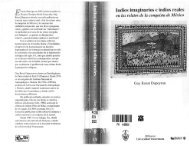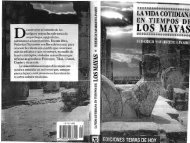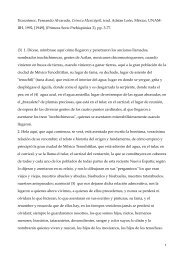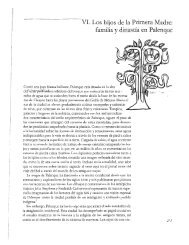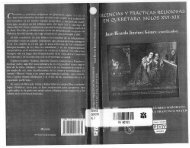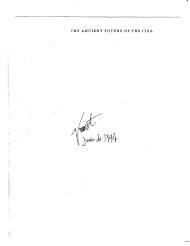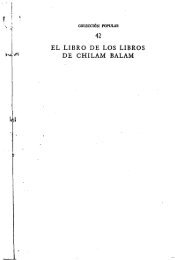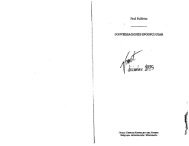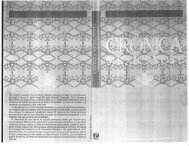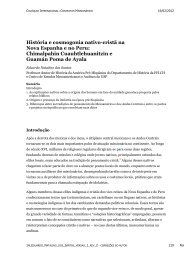HEAVEN BORN MERIDA AND ITS DESTINY - Histomesoamericana
HEAVEN BORN MERIDA AND ITS DESTINY - Histomesoamericana
HEAVEN BORN MERIDA AND ITS DESTINY - Histomesoamericana
Create successful ePaper yourself
Turn your PDF publications into a flip-book with our unique Google optimized e-Paper software.
INTRODUCTION<br />
Spanish vara (but presumably shorter, as the Maya themselves are). And<br />
above all they measured time.<br />
Not all the above units appear in the Chumayel, but a number of them<br />
are used metaphorically in relation to the calendar (particularly the fold,<br />
cup, bowl, plate, cask, foot, pace, shot, shout, and rest), and all these are<br />
frequently mentioned. The fundamental units in the counting of time<br />
were the kin 'days, suns'.<br />
The Maya had no clocks, and their conceptions of the divisions of day<br />
and night were gestural indications of the movements of the sun and stars.<br />
They were correspondingly imprecise—nothing like Greek geometry developed<br />
in Mayan mathematics. But Mayan arithmetic was sophisticated<br />
and precise, and the Mayan calendar was a marvel of both mathematical<br />
and astronomical accuracy.<br />
The number series is named in Maya in decimal fashion, with separate<br />
roots for each numeral from 1 through 10 and compounds for the numerals<br />
from 11 through 19. However, the word for '20' is simply the word<br />
for 'man' {uinic), and most higher numbers are counted vigesimally in<br />
units metaphorically equated with 20 and its multiples {kal 'armload'<br />
= 20, bak 'coil' = 400, pic '?knuckle' = 8,000, and chil ^occasions''='""<br />
3,200,000). Linguistically it was a decimal system, but conceptually it was<br />
a vigesimal one.<br />
The Tzol Kin. • The basic unit of the calendar was a period of 20 named<br />
days, the uinal (see appendix C). The names of the days are evocative, archaic,<br />
and broadly similar in meaning in the various calendar systems of<br />
nuclear Middle America, though many of them cannot be clearly translated,<br />
particularly not in Yucatec. The myth of the origin of the uinal is<br />
given in chapter 20 together with folk etymologies for the meanings of<br />
the day names. They are almost always puns. In effect, the uinal is a second<br />
and sacred number system, and it is entirely vigesimal.<br />
Along with the cycle of the day names was the cycle of the 13 sacred<br />
day numbers, the xoc kin. These were counted permutadvely and concurrently<br />
with the day names: 1 Imix, 2 Ik, 3 Akbal, 4 Kan, 5 Chicchan, etc.<br />
The number count from 1 to 13 and then from 1 to 7 completes the uinal,<br />
which the Maya noted tersely: "13 and 7 make 1." Thus the numerals 1<br />
and 7 came to represent the concepts of alpha and omega, the beginning<br />
and the end, and the unity of the divine.<br />
If a given uinal begins with 1, its successors will follow a 13-uinal sequence<br />
running 1, 8, 2, 9,3, 10, 4, 11, 5, 12, 6, 13, 7. It then starts over.<br />
Thus in this cycle, too, 1 is the beginning and 7 is the end. The completed<br />
cycle of 13 uinals constitutes a tzol kin or 'count of days'. This<br />
cycle of 260 days was the intertribal calendar of Middle America from<br />
Costa Rica to Michoacan. Because 20 has the factors 4 and 5, the Maya<br />
were impressed with the one-fifth tzol kin (4 x 13 = 52 x 5 = 260 days)<br />
and the one-quarter tzol kin (5 x 13 = 65 x 4 = 260 days) and used<br />
those cycles in ritual and divination along with the complete tzol kin of<br />
260 days.<br />
The Tun. Because the Maya counted vigesimally, it is likely that they<br />
originally counted uinals by twenties as well as by thirteens (as the Cak-<br />
chiquel<br />
days. H<br />
more cl<br />
they sei<br />
tun 'sto<br />
with thi<br />
quence.<br />
nor exp]<br />
cit in th<br />
From<br />
teenth ccounted<br />
started o<br />
cycle wa<br />
stones', i<br />
tun, all i<br />
the day /<br />
Whether<br />
days yieli<br />
Thepe<br />
13 and a i<br />
Ahau day<br />
11,9,7,5<br />
may, a cy<br />
of 365 da}<br />
use in poi<br />
gion and j<br />
There v<br />
cycle. The<br />
counted t]<br />
Chichen I<br />
Ahau. (Ab<br />
to be alluc<br />
Mayan sp«<br />
and the 11<br />
Like uin<br />
thirteens, :<br />
Long Cour<br />
this unit ai<br />
was 1, and<br />
tun, katun<br />
transcribed<br />
kins). All tl<br />
the uinals,<br />
in Maya is<br />
stopped car<br />
ing 10.6.0.C<br />
has usually



